

Compact Muon Solenoid
LHC, CERN
| CMS-TOP-17-011 ; CERN-EP-2018-321 | ||
| Measurement of the single top quark and antiquark production cross sections in the $t$ channel and their ratio in proton-proton collisions at $\sqrt{s} = $ 13 TeV | ||
| CMS Collaboration | ||
| 27 December 2018 | ||
| Phys. Lett. B 800 (2019) 135042 | ||
| Abstract: Measurements of the cross sections for the production of single top quarks and antiquarks in the $t$ channel, and their ratio, are presented for proton-proton collisions at a center-of-mass energy of 13 TeV. The data set used was recorded in 2016 by the CMS detector at the LHC and corresponds to an integrated luminosity of 35.9 fb$^{-1}$. Events with one muon or electron are selected, and different categories of jet and b jet multiplicity and multivariate discriminators are applied to separate the signal from the background. The cross sections for the $t$-channel production of single top quarks and antiquarks are measured to be 130 $\pm$ 1 (stat) $\pm$ 19 (syst) pb and 77 $\pm$ 1 (stat) $\pm$ 12 (syst) pb, respectively, and their ratio is 1.68 $\pm$ 0.02 (stat) $\pm$ 0.05 (syst). The results are in agreement with the predictions from the standard model. | ||
| Links: e-print arXiv:1812.10514 [hep-ex] (PDF) ; CDS record ; inSPIRE record ; CADI line (restricted) ; | ||
| Figures | |
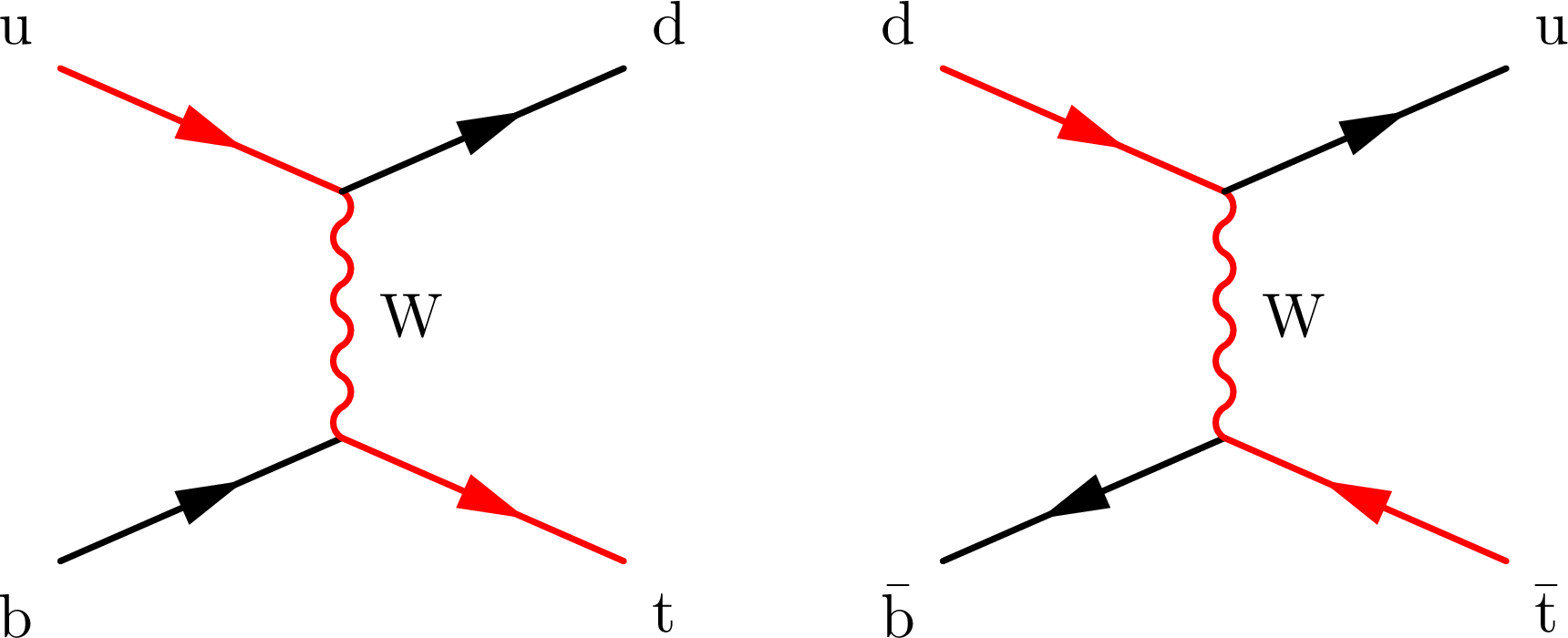
png pdf |
Figure 1:
Feynman diagrams at Born level for the electroweak production of a single top quark (left) and antiquark (right). The flavor of the light quark in the initial state--either up quark (u) or down quark (d)--defines whether a top quark or top antiquark is produced. |

png pdf |
Figure 1-a:
Feynman diagrams at Born level for the electroweak production of a single top quark (left) and antiquark (right). The flavor of the light quark in the initial state--either up quark (u) or down quark (d)--defines whether a top quark or top antiquark is produced. |

png pdf |
Figure 1-b:
Feynman diagrams at Born level for the electroweak production of a single top quark (left) and antiquark (right). The flavor of the light quark in the initial state--either up quark (u) or down quark (d)--defines whether a top quark or top antiquark is produced. |

png pdf |
Figure 2:
Event yields for the relevant processes in all categories after applying the full event selection in the muon (left) and electron (right) channels. The yields are shown separately for positively ($+$) and negatively ($-$) charged muons (electrons). The uncertainties include statistical and all systematic uncertainties. The yields are obtained from simulation, except for the QCD multijet contribution, which is derived from data (see Section 5). |

png pdf |
Figure 2-a:
Event yields for the relevant processes in all categories after applying the full event selection in the muon channel. The yields are shown separately for positively ($+$) and negatively ($-$) charged muons. The uncertainties include statistical and all systematic uncertainties. The yields are obtained from simulation, except for the QCD multijet contribution, which is derived from data (see Section 5). |

png pdf |
Figure 2-b:
Event yields for the relevant processes in all categories after applying the full event selection in the electron channel. The yields are shown separately for positively ($+$) and negatively ($-$) charged electrons. The uncertainties include statistical and all systematic uncertainties. The yields are obtained from simulation, except for the QCD multijet contribution, which is derived from data (see Section 5). |

png pdf |
Figure 3:
Outcome of the maximum likelihood fit to the ${{m_{\mathrm {T}}} ^ {\mathrm {W}}}$ distribution of events with muons (left) and to the ${{p_{\mathrm {T}}} ^\text {miss}}$ distribution for events with electrons (right) in the 2jets-1tag (upper row), 3jets-1tag (middle row), and the 2jets-0tags (lower row) categories. The QCD background template is extracted from the sideband region in data. For the fit, only statistical uncertainties are considered. |

png pdf |
Figure 3-a:
Outcome of the maximum likelihood fit to the ${{m_{\mathrm {T}}} ^ {\mathrm {W}}}$ distribution of events with muons in the 2jets-1tag category. The QCD background template is extracted from the sideband region in data. For the fit, only statistical uncertainties are considered. |
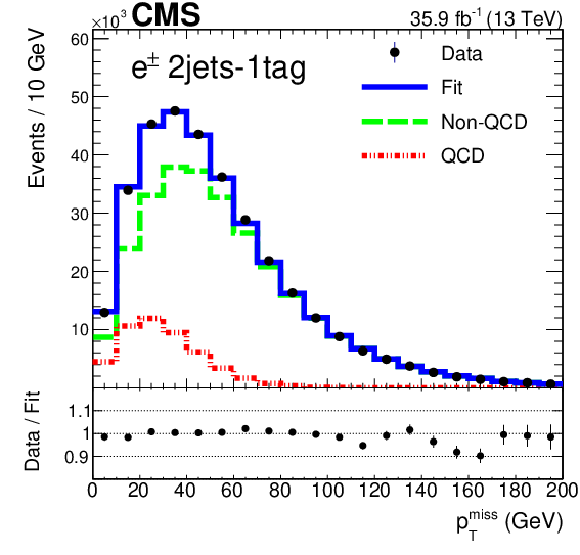
png pdf |
Figure 3-b:
Outcome of the maximum likelihood fit to the ${{p_{\mathrm {T}}} ^\text {miss}}$ distribution for events with electrons in the 2jets-1tag category. The QCD background template is extracted from the sideband region in data. For the fit, only statistical uncertainties are considered. |
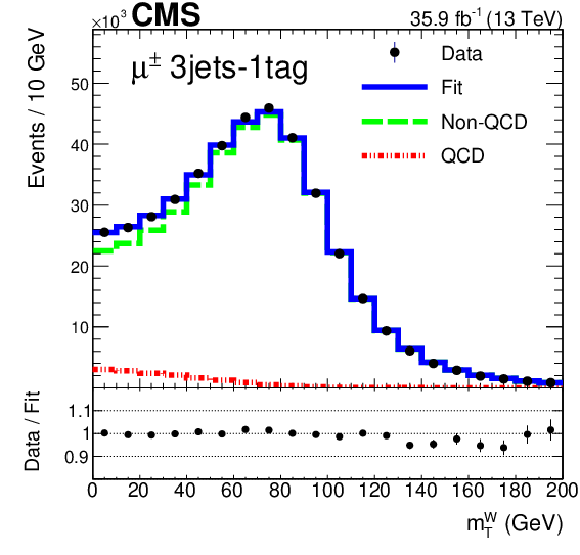
png pdf |
Figure 3-c:
Outcome of the maximum likelihood fit to the ${{m_{\mathrm {T}}} ^ {\mathrm {W}}}$ distribution of events with muons in the 3jets-1tag category. The QCD background template is extracted from the sideband region in data. For the fit, only statistical uncertainties are considered. |

png pdf |
Figure 3-d:
Outcome of the maximum likelihood fit to the ${{p_{\mathrm {T}}} ^\text {miss}}$ distribution for events with electrons in the 3jets-1tag category. The QCD background template is extracted from the sideband region in data. For the fit, only statistical uncertainties are considered. |

png pdf |
Figure 3-e:
Outcome of the maximum likelihood fit to the ${{m_{\mathrm {T}}} ^ {\mathrm {W}}}$ distribution of events with muons in the 2jets-0tags category. The QCD background template is extracted from the sideband region in data. For the fit, only statistical uncertainties are considered. |

png pdf |
Figure 3-f:
Outcome of the maximum likelihood fit to the ${{p_{\mathrm {T}}} ^\text {miss}}$ distribution for events with electrons (right) in the 2jets-0tags category. The QCD background template is extracted from the sideband region in data. For the fit, only statistical uncertainties are considered. |

png pdf |
Figure 4:
The three most discriminating input variables for the training of the BDTs in the muon channel (left) and in the electron channel (right): the absolute value of the pseudorapidity of the light-quark jet, the mass of the reconstructed top quark, the mass of the light-quark jet and the b-tagged jet associated to the top quark decay. The variables are ordered by their importance. The simulation is normalized to the total number of events in data. Also shown is the relative difference between the distributions in data and simulation in the lower panels. Here, the shaded areas correspond to the statistical uncertainties in the simulation (MC stat). |

png pdf |
Figure 4-a:
The absolute value of the pseudorapidity of the light-quark jet in the muon channel. The simulation is normalized to the total number of events in data. Also shown is the relative difference between the distributions in data and simulation in the lower panels. Here, the shaded areas correspond to the statistical uncertainties in the simulation (MC stat). |
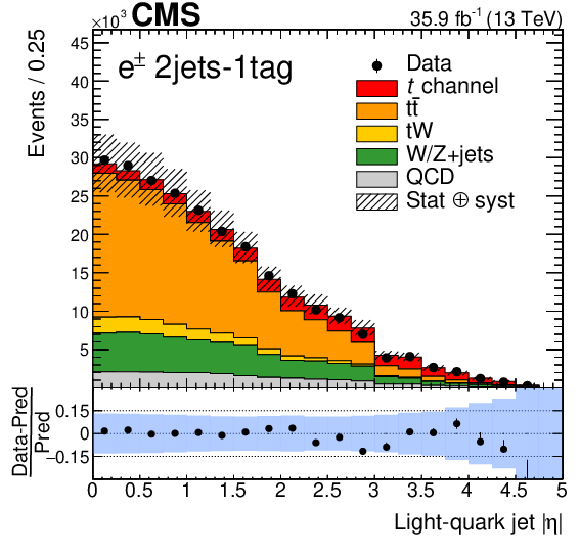
png pdf |
Figure 4-b:
The absolute value of the pseudorapidity of the light-quark jet in the muon channel. The simulation is normalized to the total number of events in data. Also shown is the relative difference between the distributions in data and simulation in the lower panels. Here, the shaded areas correspond to the statistical uncertainties in the simulation (MC stat). |

png pdf |
Figure 4-c:
The mass of the reconstructed top quark in the muon channel. The simulation is normalized to the total number of events in data. Also shown is the relative difference between the distributions in data and simulation in the lower panels. Here, the shaded areas correspond to the statistical uncertainties in the simulation (MC stat). |

png pdf |
Figure 4-d:
The mass of the reconstructed top quark in the electron channel. The simulation is normalized to the total number of events in data. Also shown is the relative difference between the distributions in data and simulation in the lower panels. Here, the shaded areas correspond to the statistical uncertainties in the simulation (MC stat). |
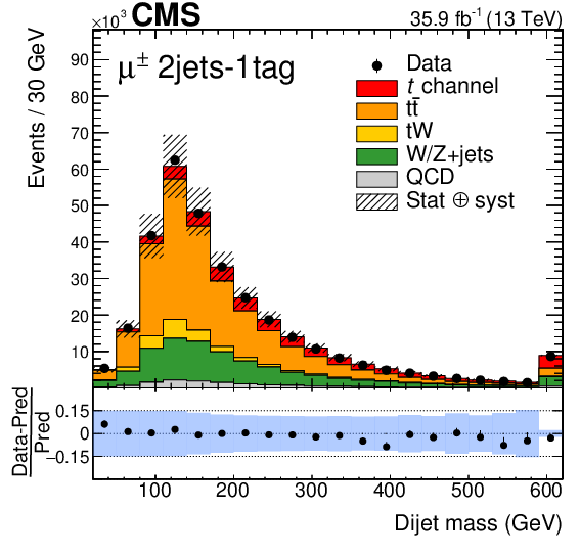
png pdf |
Figure 4-e:
The mass of the light-quark jet and the b-tagged jet associated to the top quark decay in the electron channel. The simulation is normalized to the total number of events in data. Also shown is the relative difference between the distributions in data and simulation in the lower panels. Here, the shaded areas correspond to the statistical uncertainties in the simulation (MC stat). |
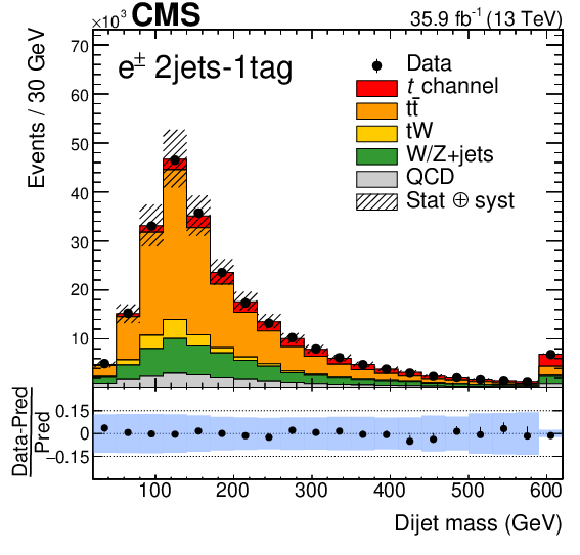
png pdf |
Figure 4-f:
The absolute value of the pseudorapidity of the light-quark jet in the electron channel. The simulation is normalized to the total number of events in data. Also shown is the relative difference between the distributions in data and simulation in the lower panels. Here, the shaded areas correspond to the statistical uncertainties in the simulation (MC stat). |

png pdf |
Figure 5:
The fourth and fifth most discriminating input variables for the training of the BDTs in the muon channel (left) and in the electron channel (right): the $\Delta {R}$ between the momentum vectors of the lepton and the b-tagged jet associated with the top quark decay, the cosine of the angle between the lepton and the light-quark jet in the rest frame of the top quark. The simulation is normalized to the total number of events in data. Also shown is the relative difference between the distributions in data and simulation in the lower panels. Here, the shaded areas correspond to the statistical uncertainties in the simulation (MC stat). |

png pdf |
Figure 5-a:
The $\Delta {R}$ between the momentum vectors of the lepton and the b-tagged jet associated with the top quark decay in the muon channel. The simulation is normalized to the total number of events in data. Also shown is the relative difference between the distributions in data and simulation in the lower panels. Here, the shaded areas correspond to the statistical uncertainties in the simulation (MC stat). |
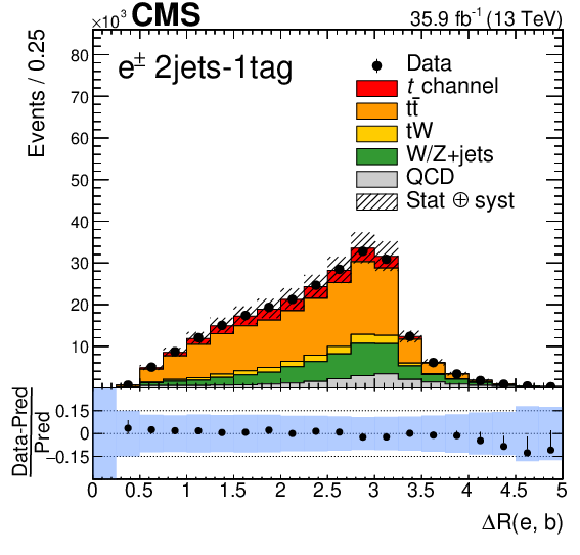
png pdf |
Figure 5-b:
The $\Delta {R}$ between the momentum vectors of the lepton and the b-tagged jet associated with the top quark decay in the electron channel. The simulation is normalized to the total number of events in data. Also shown is the relative difference between the distributions in data and simulation in the lower panels. Here, the shaded areas correspond to the statistical uncertainties in the simulation (MC stat). |

png pdf |
Figure 5-c:
The cosine of the angle between the lepton and the light-quark jet in the rest frame of the top quark in the muon channel. The simulation is normalized to the total number of events in data. Also shown is the relative difference between the distributions in data and simulation in the lower panels. Here, the shaded areas correspond to the statistical uncertainties in the simulation (MC stat). |

png pdf |
Figure 5-d:
The cosine of the angle between the lepton and the light-quark jet in the rest frame of the top quark in the electron channel. The simulation is normalized to the total number of events in data. Also shown is the relative difference between the distributions in data and simulation in the lower panels. Here, the shaded areas correspond to the statistical uncertainties in the simulation (MC stat). |
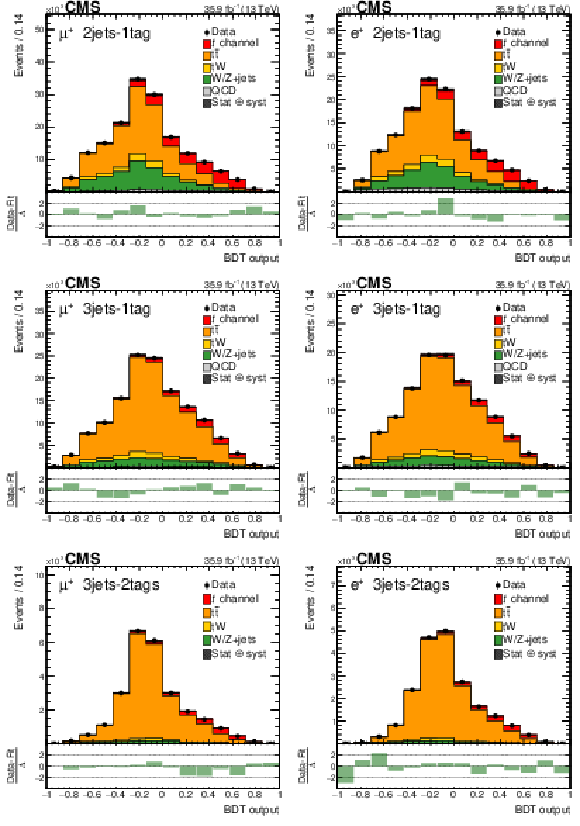
png pdf |
Figure 6:
The BDT output distributions in the 2jets-1tag category (upper row), the 3jets-1tag category (middle row), and the 3jets-2tags category (lower row) for positively charged muons (left column) and electrons (right column). The different processes are scaled to the corresponding fit results. The shaded areas correspond to the post-fit uncertainties. In each figure, the pull is also shown. |
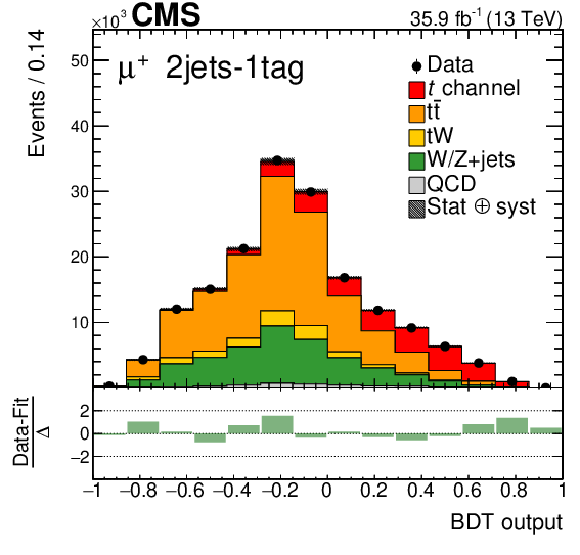
png pdf |
Figure 6-a:
The BDT output distribution in the 2jets-1tag category for positively charged muons. The different processes are scaled to the corresponding fit results. The shaded areas correspond to the post-fit uncertainties. The pull is also shown. |

png pdf |
Figure 6-b:
The BDT output distribution in the 2jets-1tag category for positively charged electrons. The different processes are scaled to the corresponding fit results. The shaded areas correspond to the post-fit uncertainties. The pull is also shown. |
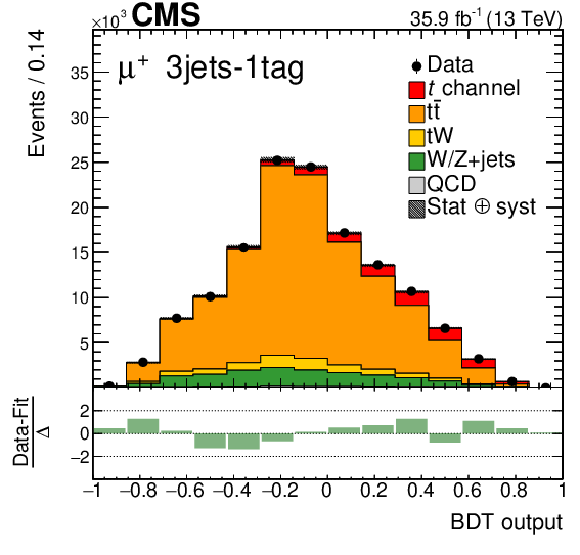
png pdf |
Figure 6-c:
The BDT output distribution in the 3jets-1tag category for positively charged muons. The different processes are scaled to the corresponding fit results. The shaded areas correspond to the post-fit uncertainties. The pull is also shown. |

png pdf |
Figure 6-d:
The BDT output distribution in the 3jets-1tag category for positively charged electrons. The different processes are scaled to the corresponding fit results. The shaded areas correspond to the post-fit uncertainties. The pull is also shown. |
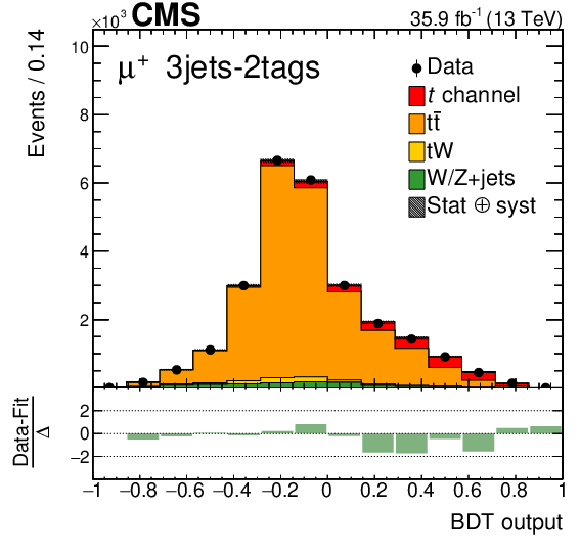
png pdf |
Figure 6-e:
The BDT output distribution in the 3jets-2tags category for positively charged muons. The different processes are scaled to the corresponding fit results. The shaded areas correspond to the post-fit uncertainties. The pull is also shown. |

png pdf |
Figure 6-f:
The BDT output distribution in the 3jets-2tags category for positively charged electrons. The different processes are scaled to the corresponding fit results. The shaded areas correspond to the post-fit uncertainties. The pull is also shown. |

png pdf |
Figure 7:
BDT output distributions in the 2jets-1tag category (upper row), the 3jets-1tag category (middle row), and the 3jets-2tags category (lower row) for negatively charged muons (left column) and electrons (right column). The different processes are scaled to the corresponding fit results. The shaded areas correspond to the post-fit uncertainties. In each figure, the pull is also shown. |
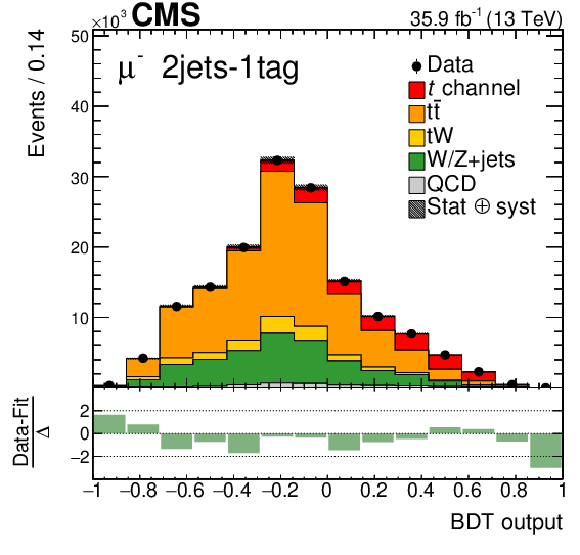
png pdf |
Figure 7-a:
BDT output distribution in the 2jets-1tag category for negatively charged muons. The different processes are scaled to the corresponding fit results. The shaded areas correspond to the post-fit uncertainties. The pull is also shown. |

png pdf |
Figure 7-b:
BDT output distribution in the 2jets-1tag category for negatively charged electrons.The different processes are scaled to the corresponding fit results. The shaded areas correspond to the post-fit uncertainties. The pull is also shown. |

png pdf |
Figure 7-c:
BDT output distribution in the 3jets-1tag category for negatively charged muons. The different processes are scaled to the corresponding fit results. The shaded areas correspond to the post-fit uncertainties. The pull is also shown. |
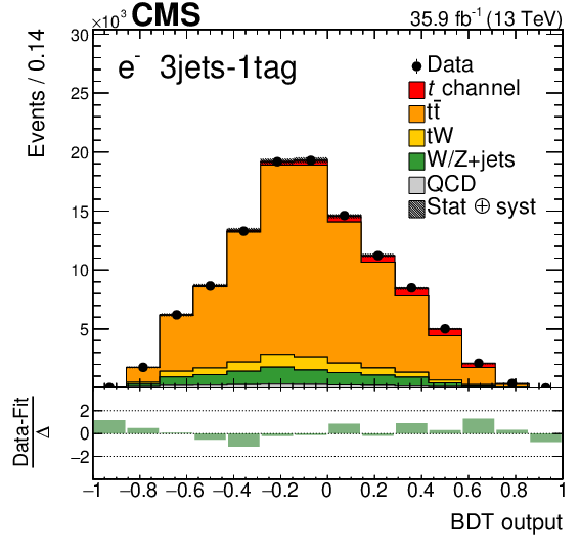
png pdf |
Figure 7-d:
BDT output distribution in the 3jets-1tag category for negatively charged electrons.The different processes are scaled to the corresponding fit results. The shaded areas correspond to the post-fit uncertainties. The pull is also shown. |

png pdf |
Figure 7-e:
BDT output distribution in the 3jets-2tags category for negatively charged muons. The different processes are scaled to the corresponding fit results. The shaded areas correspond to the post-fit uncertainties. The pull is also shown. |

png pdf |
Figure 7-f:
BDT output distribution in the 3jets-2tags category for negatively charged electrons.The different processes are scaled to the corresponding fit results. The shaded areas correspond to the post-fit uncertainties. The pull is also shown. |

png pdf |
Figure 8:
Comparison of the measured $ {R_{t\text {-ch}}} $ (central dashed line) with the NLO predictions from different PDF sets, provided by LHAPDF 6.2.1 [65]: NNPDF3.0 [39], NNPDF3.1 [66], CT14 [67], ABMP16 [68,69], MMHT2014 [70], HERAPDF2.0 [71]. The hathor 5FS calculation is used with the nominal values for the top quark pole mass and ${\alpha _S}$ set to the best values of each PDF set. The uncertainty bars for the different PDF sets include the uncertainty due to the factorization and renormalization scales, the uncertainty in the top quark pole mass, and the combined internal PDF+$ {\alpha _S}$ uncertainty. For the measurement, the statistical and total uncertainties are indicated individually by the inner and outer uncertainty bars. |
| Tables | |

png pdf |
Table 1:
Input variables for the BDTs. The variables $ {{m_{\mathrm {T}}} ^ {\mathrm {W}}} $ and lepton $ | \eta |$ are only used in the training of events with a muon, while $ {{p_{\mathrm {T}}} ^\text {miss}} $ is only considered as input for events with an electron. |
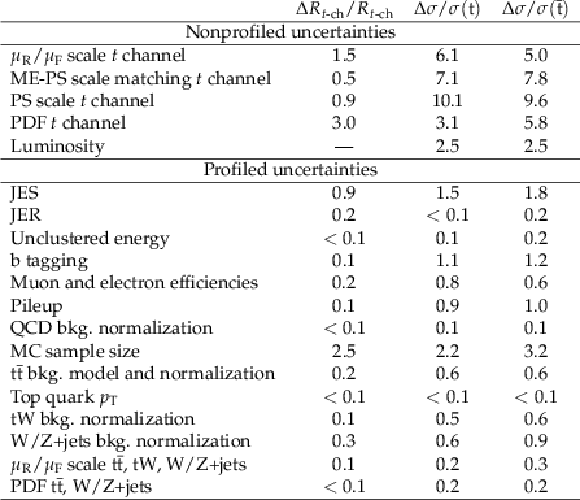
png pdf |
Table 2:
Estimated relative impact of uncertainties in percent of the measured cross sections or cross section ratio. |
| Summary |
|
Events with one muon or electron and multiple jets in the final state are used to measure the cross sections for the $t$-channel production of single top quarks and antiquarks, and their ratio. The measured cross sections are 130 $\pm$ 1 (stat) $\pm$ 19 (syst) pb for the production of single top quarks, 77 $\pm$ 1 (stat) $\pm$ 12 (syst) pb for the production of single top antiquarks, and 207 $\pm$ 2 (stat) $\pm$ 31 (syst) pb for the total production. The latter result is used to calculate the absolute value of the Cabibbo-Kobayashi-Maskawa matrix element $|{{f_{\mathrm{LV}}} {V_{\mathrm{tb}} }}| =$ 0.98 $\pm$ 0.07 (exp) $\pm$ 0.02 (theo), including an anomalous form factor ${f_{\mathrm{LV}}} $. The measured ratio of the cross sections of the two processes ${R_{t\text{-ch}}} = $ 1.68 $\pm$ 0.02 (stat) $\pm$ 0.05 (syst) is compared to recent predictions using different parton distribution functions (PDFs) to describe the inner structure of the proton. Good agreement with most PDF sets is found within the uncertainties of the measurement. The statistical uncertainty plays only a minor role for the achieved precision of the measurements, which are limited by the systematic uncertainties in the modeling of the signal process. Deeper understanding of these effects and improved procedures to estimate the uncertainty are therefore crucial to further decrease the systematic uncertainty. Because of the cancellation of systematic effects when measuring the ratio of cross sections ${R_{t\text{-ch}}} $, its precision, reported in this letter, is significantly improved with respect to the results of previous measurements. The value of ${R_{t\text{-ch}}}$ can be used to test the predictions from different PDF sets for their compatibility with the data. |
| References | ||||
| 1 | U. Husemann | Top-quark physics: Status and prospects | Prog. Part. NP 95 (2017) 48 | |
| 2 | ATLAS Collaboration | Measurement of the $ t $-channel single top-quark production cross section in pp collisions at $ \sqrt{s}= $ 7 TeV with the ATLAS detector | PLB 717 (2012) 330 | 1205.3130 |
| 3 | ATLAS Collaboration | Comprehensive measurements of $ t $-channel single top-quark production cross sections at $ \sqrt{s} = $ 7 TeV with the ATLAS detector | PRD 90 (2014) 112006 | 1406.7844 |
| 4 | ATLAS Collaboration | Fiducial, total and differential cross-section measurements of $ t $-channel single top-quark production in pp collisions at 8 TeV using data collected by the ATLAS detector | EPJC 77 (2017) 531 | 1702.02859 |
| 5 | ATLAS Collaboration | Measurement of the inclusive cross-sections of single top-quark and top-antiquark $ t $-channel production in pp collisions at $ \sqrt{s} = $ 13 TeV with the ATLAS detector | JHEP 04 (2017) 086 | 1609.03920 |
| 6 | CMS Collaboration | Measurement of the $ t $-channel single top quark production cross section in pp collisions at $ \sqrt{s}= $ 7 TeV | PRL 107 (2011) 091802 | CMS-TOP-10-008 1106.3052 |
| 7 | CMS Collaboration | Measurement of the single-top-quark $ t $-channel cross section in pp collisions at $ \sqrt{s}= $ 7 TeV | JHEP 12 (2012) 035 | CMS-TOP-11-021 1209.4533 |
| 8 | CMS Collaboration | Measurement of the $ t $-channel single-top-quark production cross section and of the $ |V_{\mathrm{tb}}| $ CKM matrix element in pp collisions at $ \sqrt{s} = $ 8 TeV | JHEP 06 (2014) 090 | CMS-TOP-12-038 1403.7366 |
| 9 | CMS Collaboration | Cross section measurement of $ t $-channel single top quark production in pp collisions at $ \sqrt s = $ 13 TeV | PLB 772 (2017) 752 | CMS-TOP-16-003 1610.00678 |
| 10 | M. Aliev et al. | HATHOR: HAdronic Top and Heavy quarks crOss section calculatoR | CPC 182 (2011) 1034 | 1007.1327 |
| 11 | P. Kant et al. | HatHor for single top-quark production: Updated predictions and uncertainty estimates for single top-quark production in hadronic collisions | CPC 191 (2015) 74 | 1406.4403 |
| 12 | A. D. Martin, W. J. Stirling, R. S. Thorne, and G. Watt | Parton distributions for the LHC | EPJC 63 (2009) 189 | 0901.0002 |
| 13 | A. D. Martin, W. J. Stirling, R. S. Thorne, and G. Watt | Uncertainties on $ \alpha_{S} $ in global PDF analyses and implications for predicted hadronic cross sections | EPJC 64 (2009) 653 | 0905.3531 |
| 14 | H.-L. Lai et al. | New parton distributions for collider physics | PRD 82 (2010) 074024 | 1007.2241 |
| 15 | R. D. Ball et al. | Parton distributions with LHC data | NPB 867 (2013) 244 | 1207.1303 |
| 16 | M. Botje et al. | The PDF4LHC Working Group Interim Recommendations | 1101.0538 | |
| 17 | S. Alekhin et al. | The PDF4LHC Working Group Interim Report | 1101.0536 | |
| 18 | E. L. Berger, J. Gao, C. P. Yuan, and H. X. Zhu | NNLO QCD Corrections to $ t $-channel Single Top-Quark Production and Decay | PRD 94 (2016) 071501 | 1606.08463 |
| 19 | CMS Collaboration | The CMS trigger system | JINST 12 (2017) P01020 | CMS-TRG-12-001 1609.02366 |
| 20 | CMS Collaboration | The CMS experiment at the CERN LHC | JINST 3 (2008) S08004 | CMS-00-001 |
| 21 | J. Alwall et al. | The automated computation of tree-level and next-to-leading order differential cross sections, and their matching to parton shower simulations | JHEP 07 (2014) 079 | 1405.0301 |
| 22 | S. Alioli, P. Nason, C. Oleari, and E. Re | NLO single-top production matched with shower in POWHEG: $s$- and $t$-channel contributions | JHEP 09 (2009) 111 | 0907.4076 |
| 23 | P. Nason | A new method for combining NLO QCD with shower Monte Carlo algorithms | JHEP 11 (2004) 040 | hep-ph/0409146 |
| 24 | S. Frixione, P. Nason, and C. Oleari | Matching NLO QCD computations with parton shower simulations: the POWHEG method | JHEP 11 (2007) 070 | 0709.2092 |
| 25 | S. Alioli, P. Nason, C. Oleari, and E. Re | A general framework for implementing NLO calculations in shower Monte Carlo programs: the POWHEG BOX | JHEP 06 (2010) 043 | 1002.2581 |
| 26 | R. Frederix, E. Re, and P. Torrielli | Single-top $ t $-channel hadroproduction in the four-flavour scheme with POWHEG and aMC@NLO | JHEP 09 (2012) 130 | 1207.5391 |
| 27 | S. Alioli, S.-O. Moch, and P. Uwer | Hadronic top-quark pair-production with one jet and parton showering | JHEP 01 (2012) 137 | 1110.5251 |
| 28 | M. Czakon and A. Mitov | Top++: A program for the calculation of the top-pair cross-section at hadron colliders | CPC 185 (2014) 2930 | 1112.5675 |
| 29 | E. Re | Single-top Wt-channel production matched with parton showers using the POWHEG method | EPJC 71 (2011) 1547 | 1009.2450 |
| 30 | N. Kidonakis | Two-loop soft anomalous dimensions for single top quark associated production with a W- or H- | PRD 82 (2010) 054018 | 1005.4451 |
| 31 | N. Kidonakis | Top quark production | in Proceedings, Helmholtz International Summer School on Physics of Heavy Quarks and Hadrons (HQ 2013): JINR, Dubna 2013 | 1311.0283 |
| 32 | R. Frederix and S. Frixione | Merging meets matching in MC@NLO | JHEP 12 (2012) 061 | 1209.6215 |
| 33 | R. Gavin, Y. Li, F. Petriello, and S. Quackenbush | FEWZ 2.0: A code for hadronic Z production at next-to-next-to-leading order | CPC 182 (2011) 2388 | 1011.3540 |
| 34 | R. Gavin, Y. Li, F. Petriello, and S. Quackenbush | W physics at the LHC with FEWZ 2.1 | CPC 184 (2013) 208 | 1201.5896 |
| 35 | Y. Li and F. Petriello | Combining QCD and electroweak corrections to dilepton production in FEWZ | PRD 86 (2012) 094034 | 1208.5967 |
| 36 | T. Sjostrand et al. | An introduction to PYTHIA 8.2 | CPC 191 (2015) 159 | 1410.3012 |
| 37 | CMS Collaboration | Event generator tunes obtained from underlying event and multiparton scattering measurements | EPJC 76 (2016) 155 | CMS-GEN-14-001 1512.00815 |
| 38 | CMS Collaboration | Investigations of the impact of the parton shower tuning in Pythia 8 in the modelling of $ \mathrm{t\overline{t}} $ at $ \sqrt{s}= $ 8 and 13 TeV | CMS-PAS-TOP-16-021 | CMS-PAS-TOP-16-021 |
| 39 | NNPDF Collaboration | Parton distributions for the LHC Run II | JHEP 04 (2015) 040 | 1410.8849 |
| 40 | GEANT4 Collaboration | GEANT4--a simulation toolkit | NIMA 506 (2003) 250 | |
| 41 | M. Cacciari, G. P. Salam, and G. Soyez | The anti-$ {k_{\mathrm{T}}} $ jet clustering algorithm | JHEP 04 (2008) 063 | 0802.1189 |
| 42 | M. Cacciari, G. P. Salam, and G. Soyez | FastJet user manual | EPJC 72 (2012) 1896 | 1111.6097 |
| 43 | CMS Collaboration | Particle-flow reconstruction and global event description with the CMS detector | JINST 12 (2017) P10003 | CMS-PRF-14-001 1706.04965 |
| 44 | CMS Collaboration | Performance of the CMS muon detector and muon reconstruction with proton-proton collisions at $ \sqrt{s} = $ 13 TeV | JINST 13 (2018) P06015 | CMS-MUO-16-001 1804.04528 |
| 45 | W. Adam, R. Fruhwirth, A. Strandlie, and T. Todorov | Reconstruction of electrons with the Gaussian-sum filter in the CMS tracker at the LHC | JPG 31 (2005) 9 | physics/0306087 |
| 46 | CMS Collaboration | Jet energy scale and resolution in the CMS experiment in pp collisions at 8 TeV | JINST 12 (2017) P02014 | CMS-JME-13-004 1607.03663 |
| 47 | CMS Collaboration | Identification of heavy-flavour jets with the CMS detector in pp collisions at 13 TeV | JINST 13 (2018) P05011 | CMS-BTV-16-002 1712.07158 |
| 48 | CMS Collaboration | Performance of missing energy reconstruction in 13 TeV pp collision data using the CMS detector | CMS-PAS-JME-16-004 | CMS-PAS-JME-16-004 |
| 49 | D0 Collaboration | Observation of single top-quark production | PRL 103 (2009) 092001 | 0903.0850 |
| 50 | CDF Collaboration | First observation of electroweak single top quark production | PRL 103 (2009) 092002 | 0903.0885 |
| 51 | J. Therhaag et al. | TMVA---toolkit for multivariate data analysis | in Proceedings, Int'l Conf. on Computational Methods in Science and Engineering, 2009, ICCMSE2009 | |
| 52 | A. Kalogeropoulos and J. Alwall | The SysCalc code: A tool to derive theoretical systematic uncertainties | 1801.08401 | |
| 53 | CMS Collaboration | CMS luminosity measurements for the 2016 data taking period | CMS-PAS-LUM-17-001 | CMS-PAS-LUM-17-001 |
| 54 | CMS Collaboration | Determination of jet energy calibration and transverse momentum resolution in CMS | JINST 6 (2011) P11002 | CMS-JME-10-011 1107.4277 |
| 55 | CMS Collaboration | Performance of the CMS missing transverse momentum reconstruction in pp data at $ \sqrt{s} = $ 8 TeV | JINST 10 (2015) P02006 | CMS-JME-13-003 1411.0511 |
| 56 | CMS Collaboration | Measurements of inclusive $ \mathrm{W} $ and $ \mathrm{Z} $ cross sections in pp collisions at $ \sqrt{s}= $ 7 TeV | JHEP 01 (2011) 080 | CMS-EWK-10-002 1012.2466 |
| 57 | CMS Collaboration | Measurement of the inelastic proton-proton cross section at $ \sqrt{s}= $ 13 TeV | JHEP 07 (2018) 161 | CMS-FSQ-15-005 1802.02613 |
| 58 | R. Barlow and C. Beeston | Fitting using finite Monte Carlo samples | Comp. Phys. Commun. 77 (1993) 219 | |
| 59 | M. Czakon, P. Fiedler, and A. Mitov | Total top-quark pair-production cross section at hadron colliders through $ O(\alpha^{4}_{S}) $ | PRL 110 (2013) 252004 | 1303.6254 |
| 60 | CMS Collaboration | Measurement of differential cross sections for top quark pair production using the lepton+jets final state in proton-proton collisions at 13 TeV | PRD 95 (2017) 092001 | CMS-TOP-16-008 1610.04191 |
| 61 | CMS Collaboration | Measurement of normalized differential $ \mathrm{t}\overline{\mathrm{t}} $ cross sections in the dilepton channel from pp collisions at $ \sqrt{s}= $ 13 TeV | JHEP 04 (2018) 060 | CMS-TOP-16-007 1708.07638 |
| 62 | CMS Collaboration | Measurement of the production cross section for single top quarks in association with W bosons in proton-proton collisions at $ \sqrt{s}= $ 13 TeV | JHEP 10 (2018) 117 | CMS-TOP-17-018 1805.07399 |
| 63 | J. A. Aguilar-Saavedra | A Minimal set of top anomalous couplings | NPB 812 (2009) 181 | 0811.3842 |
| 64 | G. J. Feldman and R. D. Cousins | A Unified approach to the classical statistical analysis of small signals | PRD 57 (1998) 3873 | physics/9711021 |
| 65 | A. Buckley et al. | LHAPDF6: parton density access in the LHC precision era | EPJC 75 (2015) 132 | 1412.7420 |
| 66 | NNPDF Collaboration | Parton distributions from high-precision collider data | EPJC 77 (2017) 663 | 1706.00428 |
| 67 | S. Dulat et al. | New parton distribution functions from a global analysis of quantum chromodynamics | PRD 93 (2016) 033006 | 1506.07443 |
| 68 | S. Alekhin, J. Blumlein, S.-O. Moch, and R. Placakyte | Parton distribution functions, $ \alpha_s $, and heavy-quark masses for LHC Run II | PRD 96 (2017) 014011 | 1701.05838 |
| 69 | S. Alekhin, J. Blumlein, and S.-O. Moch | NLO PDFs from the ABMP16 fit | EPJC 78 (2018) 477 | 1803.07537 |
| 70 | L. A. Harland-Lang, A. D. Martin, P. Motylinski, and R. S. Thorne | Parton distributions in the LHC era: MMHT 2014 PDFs | EPJC 75 (2015) 204 | 1412.3989 |
| 71 | ZEUS and H1 Collaborations | Combined measurement and QCD analysis of the inclusive $ \mathrm{e}^{\pm} $p scattering cross sections at HERA | JHEP 01 (2010) 109 | 0911.0884 |

|
Compact Muon Solenoid LHC, CERN |

|

|

|

|

|

|